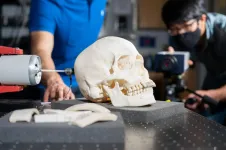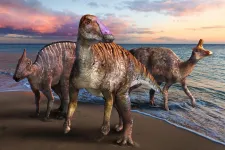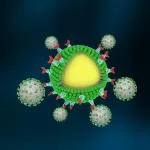(Press-News.org) Irvine, Calif., April 27, 2021 -- University of California, Irvine biologists have developed a new genetically engineered mouse model that, unlike its predecessors, is based on the most common form of Alzheimer's disease. The advance holds promise for making new strides against the neurodegenerative disease as cases continue to soar. Their study appears in the journal, Nature Communications.
Link to study: https://www.nature.com/articles/s41467-021-22624-z
While over 170 Alzheimer's mouse models have been in use since the 1990s, those models mimic early-onset AD, also known as "familial AD," which accounts for less than 5 percent of total AD cases. Until recently, scientists introduced mutations found in familial risk human genes, such as the amyloid precursor protein and presenilin 1, into the mouse genome to generate the mouse models. The UCI team decided to take a new approach by developing a mouse model better positioned to analyze causes of late-onset AD. Also called "sporadic AD," this new model encompasses the remaining 95 percent of cases.
"We believed models developed on the rare familial type might be a reason therapies have worked in the lab but haven't translated into clinical trial success," said Frank LaFerla, professor of neurobiology & behavior and the study's co-senior author; he is also dean of the UCI School of Biological Sciences and director of the UCI Alzheimer's Disease Research Center. "We decided it was time to begin developing a model that embodies the far more common late-onset form of AD."
"The existing AD models have been invaluable to the field by helping provide a better understanding of the pathogenesis of the disease." said David Baglietto-Vargas, assistant research professor of neurobiology & behavior and the study's first author. "Unfortunately, many of those same models have unique physiological alterations that have led scientists to misinterpret some experimental findings."
Rather than introduce mutations from familial-AD risk genes into the mouse, the UCI team generated the new model by using genetic engineering to switch three amino acids in the mouse amyloid precursor protein to make it more closely mirror its human counterpart. The result is what the researchers are calling a "platform model" for late-onset AD.
While the mice don't display the more advanced brain plaque and tangle pathology linked with the disease, the model manifests AD-associated conditions that precede and likely underline more advanced pathology. These AD-related conditions include age-related alterations in cognition, inflammation, brain volume and others consistent with human changes.
"This model can be used to understand very early events in the brain that may be relevant," said Kim Green, professor and vice-chair of neurobiology & behavior and co-senior author of the study. "We can use environmental and genetic factors to examine which aspects of aging are important in developing late-onset AD."
"This mouse is a foundational step toward modeling late-onset AD with its hallmark features of plaques and tangles," said Grant MacGregor, professor of developmental & cell biology and study co-author. "It will take a lot more time and inclusion of additional subtle AD-associated genetic changes to achieve it, but the result of this study suggests we are on the right path and that our approach may bear fruit."
Unless there are medical breakthroughs, the number of Americans 65 and older with Alzheimer's could rise from 6.2 million currently to 12.7 million by 2050, according to the Alzheimer's Association.
INFORMATION:
Support for this research was initiated by the generosity of Mr. Harry Bubb through the Cure Alzheimer's Fund. Additional support was provided by the Alzheimer's Association, the Larry L. Hillblom Foundation, the National Institutes of Health, the BrightFocus Foundation, Minister of Science and Innovation, Carlos III Institute of Health, the American Federation for Aging Research, UCI and the UCI Institute for Memory Impairments and Neurological Disorders.
Just as humans receive the first members of their microbiomes from their mothers, seeds may harbor some of the first microorganisms plants encounter. While these initial microbes could become influential players in the plants' microbiomes, the microbial communities that colonize seeds have not received as much attention as root, shoot, or soil microbiomes. To understand how seed microbiomes are assembled, a group of researchers at the University of Saskatchewan (Canada) examined the relative effects of growth environment and plant genotype on the seed microbiome of canola, a globally important crop grown in diverse environments.
In their recently published paper in Phytobiomes Journal, ...
It's easy to think that more nutrients -- the stuff life needs to grow and thrive -- would foster more vibrant ecosystems. Yet nutrient pollution has in fact wrought havoc on marine systems, contributing to harmful algae blooms, worse water quality and oxygen-poor dead zones.
A team of researchers from UC Santa Barbara has proposed a novel strategy for reducing large amounts of nutrients -- specifically nitrogen and phosphorous -- after they have already been released into the environment. In a study appearing in the journal Marine Policy, the authors contend that seaweed's incredible ability to draw nutrients from the water could provide an efficient and cost-effective solution. Looking at the U.S. Gulf of Mexico, the team identified over 63,000 square kilometers suitable for seaweed aquaculture.
"A ...
The discovery of a novel enzyme that releases a valuable chemical from agricultural waste could provide an important breakthrough in the upscaling of renewable fuels and chemicals, a new study shows.
Researchers - led by the University of York - have discovered an enzyme in a fungus which can act as a catalyst to bring about a biochemical reaction that breaks down lignocellulose
Lignocellulose is found in forestry and agricultural waste like wheat straw, which was used in this research. It has long been considered by scientists that this dry matter could ...
A team of engineering researchers at the Georgia Institute of Technology hopes to uncover new ways to diagnose and treat brain ailments, from tumors and stroke to Parkinson's disease, leveraging vibrations and ultrasound waves.
The five-year, $2 million National Science Foundation (NSF) project initiated in 2019 already has resulted in several published journal articles that offer promising new methods to focus ultrasound waves through the skull, which could lead to broader use of ultrasound imaging -- considered safer and less expensive than magnetic resonance imaging (MRI) technology.
Specifically, the team is researching a broad range of frequencies, spanning low frequency vibrations (audio frequency range) and moderate frequency guided waves (100 kHz to 1 MHz) to high ...
DALLAS (SMU) - An international team of paleontologists has identified a new genus and species of hadrosaur or duck-billed dinosaur, Yamatosaurus izanagii, on one of Japan's southern islands.
The fossilized discovery yields new information about hadrosaur migration, suggesting that the herbivors migrated from Asia to North America instead of vice versa. The discovery also illustrates an evolutionary step as the giant creatures evolved from walking upright to walking on all fours. Most of all, the discovery provides new information and asks new questions about dinosaurs in Japan.
The research, "A New Basal Hadrosaurid (Dinosauria: Ornithischia) From the latest Cretaceous Kita-ama Formation in Japan implies the origin of Hadrosaurids," ...
Researchers at the Pritzker School of Molecular Engineering (PME) at the University of Chicago have designed a completely novel potential treatment for COVID-19: nanoparticles that capture SARS-CoV-2 viruses within the body and then use the body's own immune system to destroy it.
These "Nanotraps" attract the virus by mimicking the target cells the virus infects. When the virus binds to the Nanotraps, the traps then sequester the virus from other cells and target it for destruction by the immune system.
In theory, these Nanotraps could also be used on variants of the virus, leading to a potential new way to inhibit the virus going forward. Though the therapy remains in early stages of testing, the researchers envision it could be administered ...
In a paper published in the journal Scientific Reports, researchers from Surrey investigated whether the daily consumption of a prebiotic food supplement could improve overall wellbeing in a group of 18 to 25 year-olds. The study found that those who received a daily dose of prebiotics improved mental wellbeing by reducing anxiety levels and had better gut health than the control group.
Researchers studied a group of 64 healthy female participants with no current or previous clinical diagnoses of anxiety. Participants received either a daily dose of the prebiotic galacto-oligosaccharides (GOS) or a placebo for 28 days.
All those involved in the trial completed surveys about their health experiences, including mood, anxiety and sleep quality and provided a stool sample ...
New studies from the Center for Advanced Bioenergy and Bioproducts Innovation (CABBI) shed more light on the economic and environmental costs of mandates in the Renewable Fuels Standard (RFS), a federal program to expand the nation's biofuels sector.
Researchers said the studies indicate the need to adopt more targeted policies that value the environmental and ecosystem benefits of perennial bioenergy crops over cheaper options -- and provide financial incentives for farmers to grow them.
The RFS was issued in 2005 and updated through the Energy Independence and Security Act of 2007 ...
MEMPHIS, Tenn. - For the first time in published literature, Le Bonheur Children's Hospital and University of Tennessee Health Science Center (UTHSC) researchers showed that a variety of white blood cells known as eosinophils modify the respiratory barrier during influenza A (IAV) infection, according to a recent paper in the journal Cells. This research could have implications in understanding SARS-CoV-2 (COVID-19) infection in asthmatic patients.
The Le Bonheur/UTHSC study found that eosinophils immunomodulate airway epithelial cells during IAV infection, helping to neutralize the virus and ...
The legend of the "kraken" has captivated humans for millennia. Stories of deep-sea squid dragging sailors and even entire ships to their doom can be found in everything from ancient Greek mythology to modern-day movie blockbusters. It is therefore ironic that the species that inspired these stories, the giant squid Architeuthis dux, is camera-shy. In fact, filming this species in the wild has proven an insurmountable challenge for countless scientists, explorers, and filmmakers. To date, only one scientist, Dr. Edith Widder of the Ocean Research & Conservation Association, has repeatedly caught a live giant squid on camera. In a new study, Dr. Widder and her colleagues have finally revealed the secrets behind their success. This study, which is free to access, also ...




